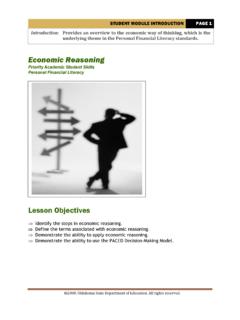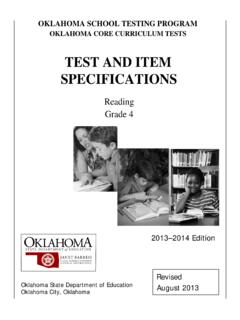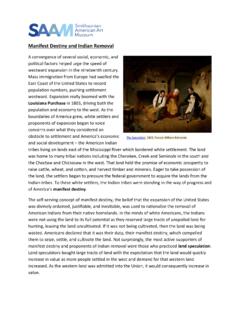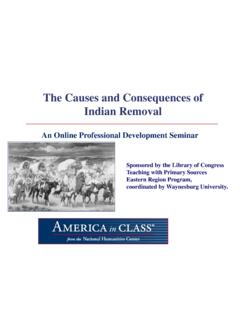Transcription of The Choctaw Nation of Oklahoma
1 1 July 2014 Oklahoma INDIAN TRIBE EDUCATION GUIDE The Choctaw Nation of Oklahoma ( Oklahoma Social Studies Standards, OSDE) Tribe: The Choctaw Nation of Oklahoma Tribal websites: 1. Migration/movement/forced removal Oklahoma History C3 Standard Integrate visual and textual evidence to explain the reasons for and trace the migrations of Native American peoples including the Five Tribes into present-day Oklahoma , the indian removal Act of 1830, and tribal resistance to the forced relocations. Choctaw Origins The Choctaw homeland comprises present-day western Alabama, eastern Mississippi, and the Florida panhandle. The Tribe s presence in this area is explained through two ancient stories handed down from generation to generation.
2 The first story tells of Choctaw people being created underground, along with other southeastern tribes including the Chickasaw, Cherokee, and Muscogee Creek . After the other Tribes emerged onto the surface of the earth through a cave and moved to different regions, the Choctaw people emerged and were told by the creator that they were to stay in that area, which would become the Choctaw homeland. Nearby, the Choctaw built Nvnih Waiya, the first Choctaw village. The second origins story tells of the journey of two brothers, Chahta and Chikasha and their people. According to this story, God (Hvshtahli) instructed a holy man to stick a sacred pole upright in the ground, and in the morning, the pole would lean in the direction that God wanted the people to travel to find a new homeland.
3 Every morning for months or according to some versions of the story for many years, the pole leaned towards the southeast and the people daily walked in that direction. Finally, one morning near Nvnih Waiya Creek, the pole appeared to be standing straight and the Choctaw people knew that they had reached their home. Near the end of their journey, the two brothers argued, and as a result Chikasha and his less numerous supporters separated from the main body of the people. Chahta and his people became known as the Choctaw Tribe while Chikasha and his people became known as the Chickasaw Tribe. To Choctaw people, these two stories, though different, are not contradictory. It may be that they describe once separate groups of people that joined together to make up today s Choctaw people.
4 2 July 2014 indian removal Act of 1830 Many years later, most Choctaw people were removed from the homeland to what is now southeastern Oklahoma . This came about as a result of the indian removal Act, made into law on May 28, 1830. Created by President Andrew jackson , the indian removal Act called for all Tribes east of the Mississippi River to be removed west of the Mississippi River to Indian Territory. After years of signing treaties that slowly eroded away their land base, in September of 1830, the Choctaw people again assembled with representatives of the United States at Dancing Rabbit Creek in Noxubee County, Mississippi to negotiate a treaty. At the meeting, the US representatives threatened the unprovoked destruction of the Choctaw people, if Tribal representatives would not sign a final Treaty, ceding the last of Choctaw lands east of the Mississippi River to the United States.
5 The treaty, did allow for Choctaws wishing to remain in Mississippi to do so with dual citizenship. After much resistance, the Choctaws signed the Treaty of Dancing Rabbit Creek on September 27, 1830. removal removal happened in three waves, 1831-1833, 1845-1854, and 1902-1903. The years of removal are a tragic period in Choctaw history. Roughly 20,000 Choctaws were forced to leave their homes in Mississippi. Choctaw emigrants in the 1830s, faced some of the worst winters in recorded history. Government provisions, called for by treaty were often inadequate or simply non-existent. With the lack of shelter and clothing, death became rampant, and the journey was named The Trail of Tears . It is estimated that more than 2,500 Choctaw men, women, and children, died on their journey to Oklahoma in the 1830s.
6 The descendants of those who survived the trip are today s Choctaw Nation of Oklahoma . Despite every effort from the United States government, some Choctaws steadfastly remained in the homeland. Although land allotments had been promised to them in the Treaty of Dancing Rabbit Creek, most allotments were never provided. Choctaws became sharecroppers in their own land. Descendants of the Choctaw people who stayed in Mississippi make up today s Mississippi Band of Choctaw indians . Members of the Jena Band of Choctaw indians are descended from Choctaw people who remained in Louisiana. 2. Maps Oklahoma History C3 Standard Integrate visual and textual evidence to explain the reasons for and trace the migrations of Native American peoples including the Five Tribes into present-day Oklahoma , the indian removal Act of 1830, and tribal resistance to the forced relocations.
7 3 July 2014 Rebuilding After reaching Indian Territory, the Choctaws set about to regain some sense of order out of the chaos they had endured. A new constitution was written, one that mirrored that of the United States, and a national court system was developed. The Choctaw capital was set in Tushkahoma. The Choctaws also established their own form of law enforcement called the Lighthorse. In 1866, Choctaw Chief Allen Wright named the new land Oklahoma , a term that means Red People in the Choctaw language. 4 July 2014 Oklahoma History C3 Standard Compare and contrast multiple points of view to evaluate the impact of the Dawes Act which resulted in the loss of tribal communal lands and the redistribution of lands by various means including land runs as typified by the Unassigned Lands and the Cherokee Outlet, lotteries, and tribal allotments.
8 The Dawes of 1887 once again set out to break up the communally held lands of the Choctaws. Eventually each Choctaw was enrolled on the Dawes Rolls and issued an allotment of land. The Dawes Rolls are still used in deciding tribal membership today. 3. Population Past/Present Today, the citizenship of the Choctaw Nation of Oklahoma is comprised of people who are directly descended from Choctaw individuals on the Dawes Roll. With a membership of over 200,000 the Choctaw Nation of Oklahoma is today the third largest Tribe in the country. 4. Government; Chiefs vs Chairman; Elected or Paternal US Government C3 Standard Summarize and explain the relationships and the responsibilities between national and state governments including tribal and local governments. Public Law 91-495 authorized the Choctaws in 1970 to select their own officers through popular election, and the Choctaw Constitution was adopted in 1983, reviving their 1860 Constitution with updated modifications.
9 The tribal Nation is guided by an elected 12-member council with a chief. As a domestic dependent sovereign , the Choctaw Nation of Oklahoma operates on lands reserved for their exclusive use and supports policing, judicial, educational, and health branches which maintain services for their citizens. Oklahoma History C3 Standard The student will analyze the formation and development of constitutional government in Oklahoma . 1) Compare and contrast the development of governments among the Native American tribes, the movement for the state of Sequoyah .. 2) Describe and summarize attempts to create a state constitution joining Indian and Oklahoma Territories including the impact of the Progressive and Labor Movements resulting in statehood on November 16, 1907. The Choctaw Nation government consists of an elected Chief, Assistant Chief, and a 12 member Tribal Council.
10 Each member of the Tribal Council represents a district of the 10 counties of the Choctaw Nation . Gary Batton is the current chief of the Choctaw Nation of Oklahoma with Jack Austin, Jr. serving as assistant chief. 5 July 2014 5. Language Group Oklahoma History C3 Standard Compare and contrast the successes and failures of the United States policy of assimilation of the Native Americans in Oklahoma including the passage of the Indian Citizenship Act of 1924 and the effects of the Indian Boarding Schools (1880s-1940s) upon Native Americans identity, culture, traditions, and tribal government and sovereignty. The Choctaw language is considered a part of the western Muskogean language group, and is closely related to the language spoken by the Chickasaw Tribe. The last 30 years has seen a resurgence in efforts to preserve and strengthen the Choctaw Nation s culture and heritage.















